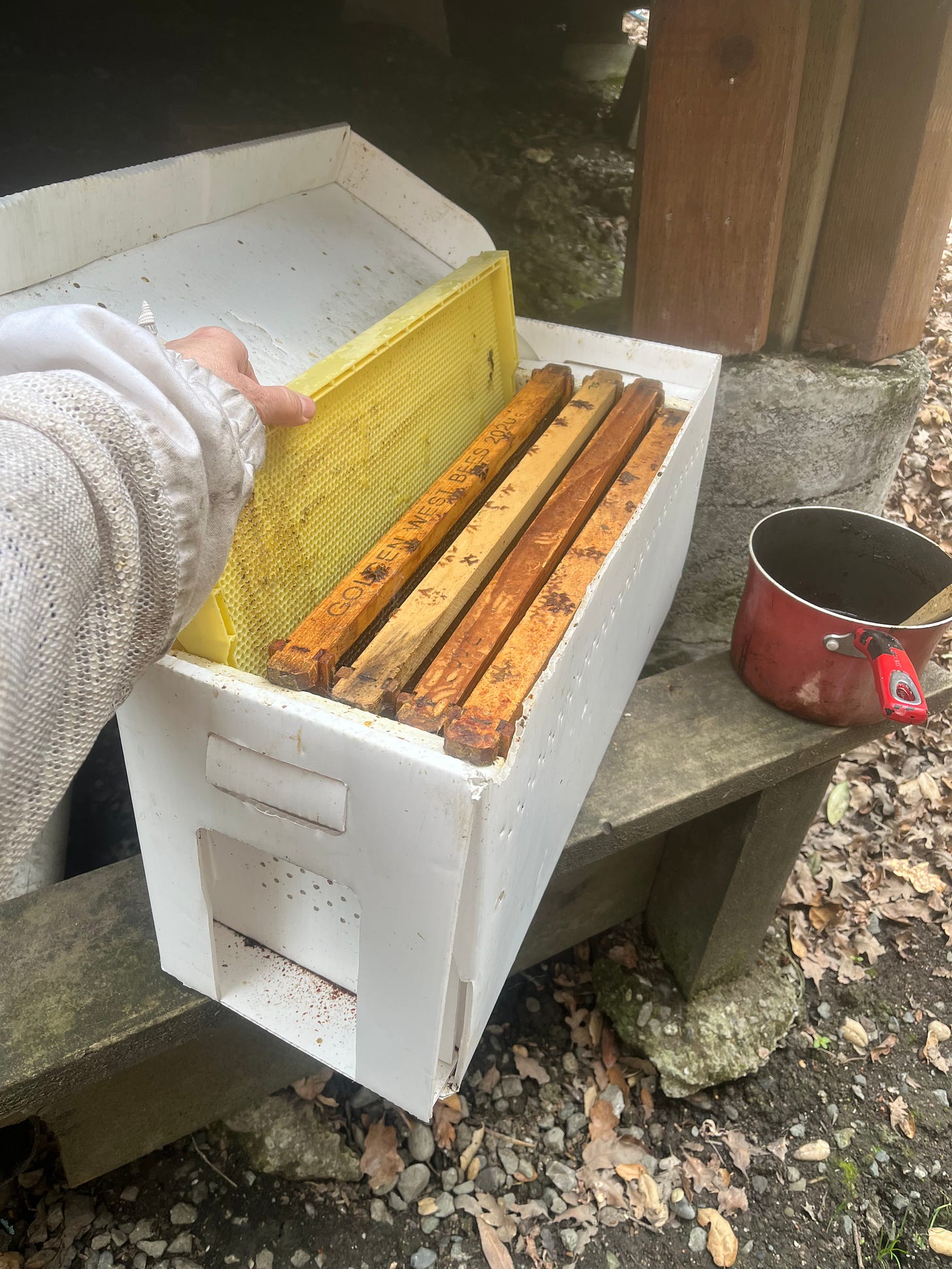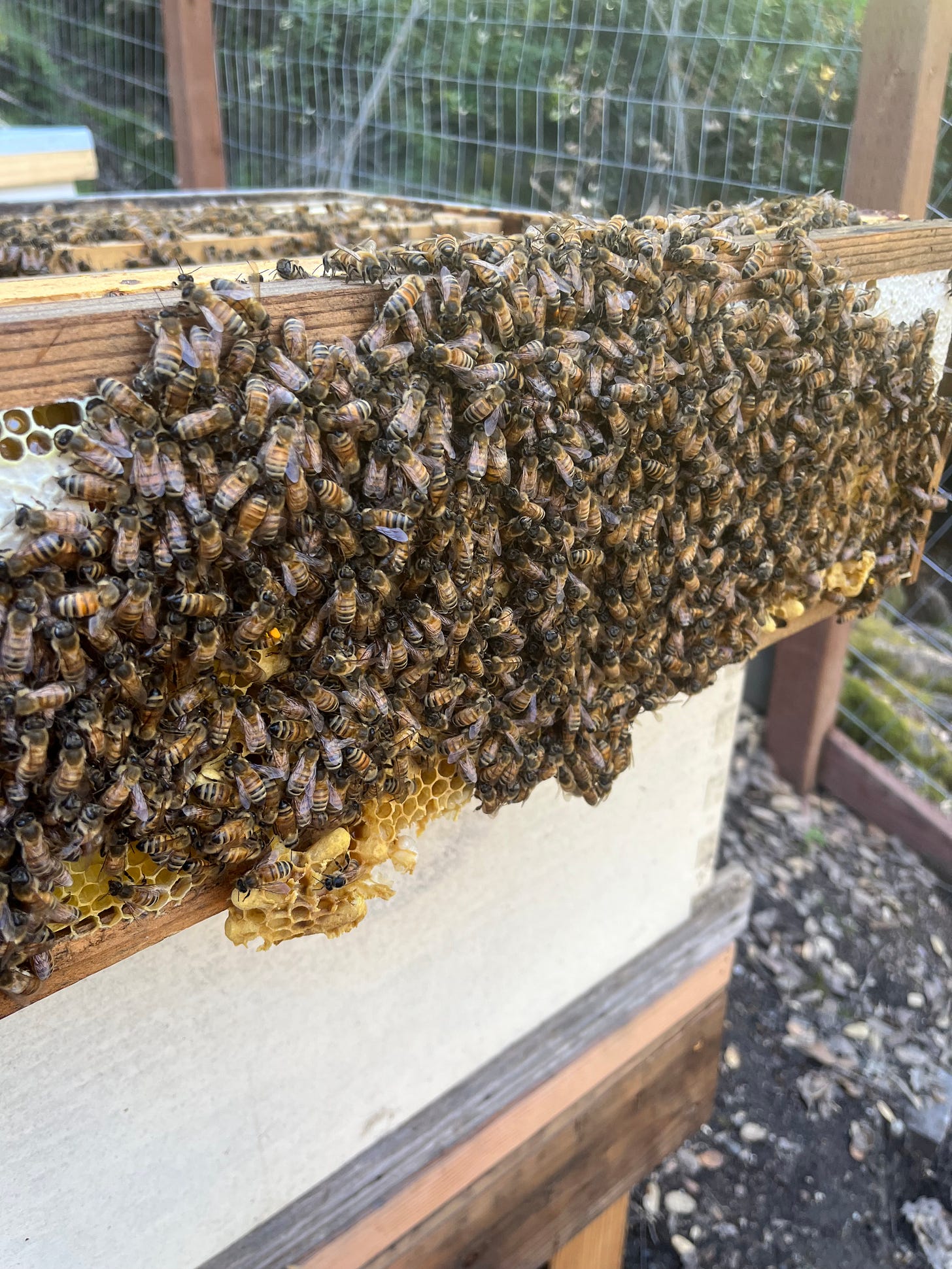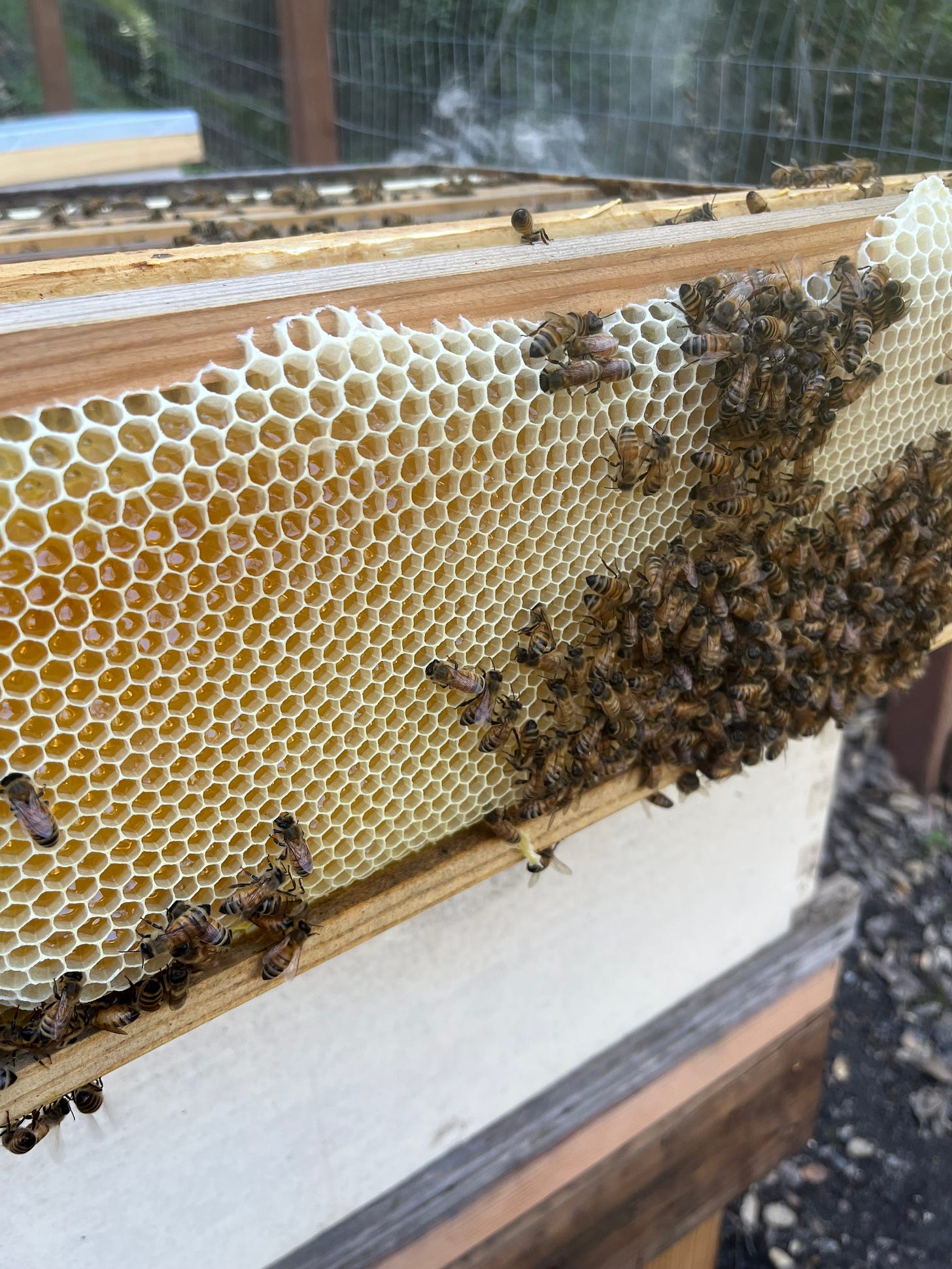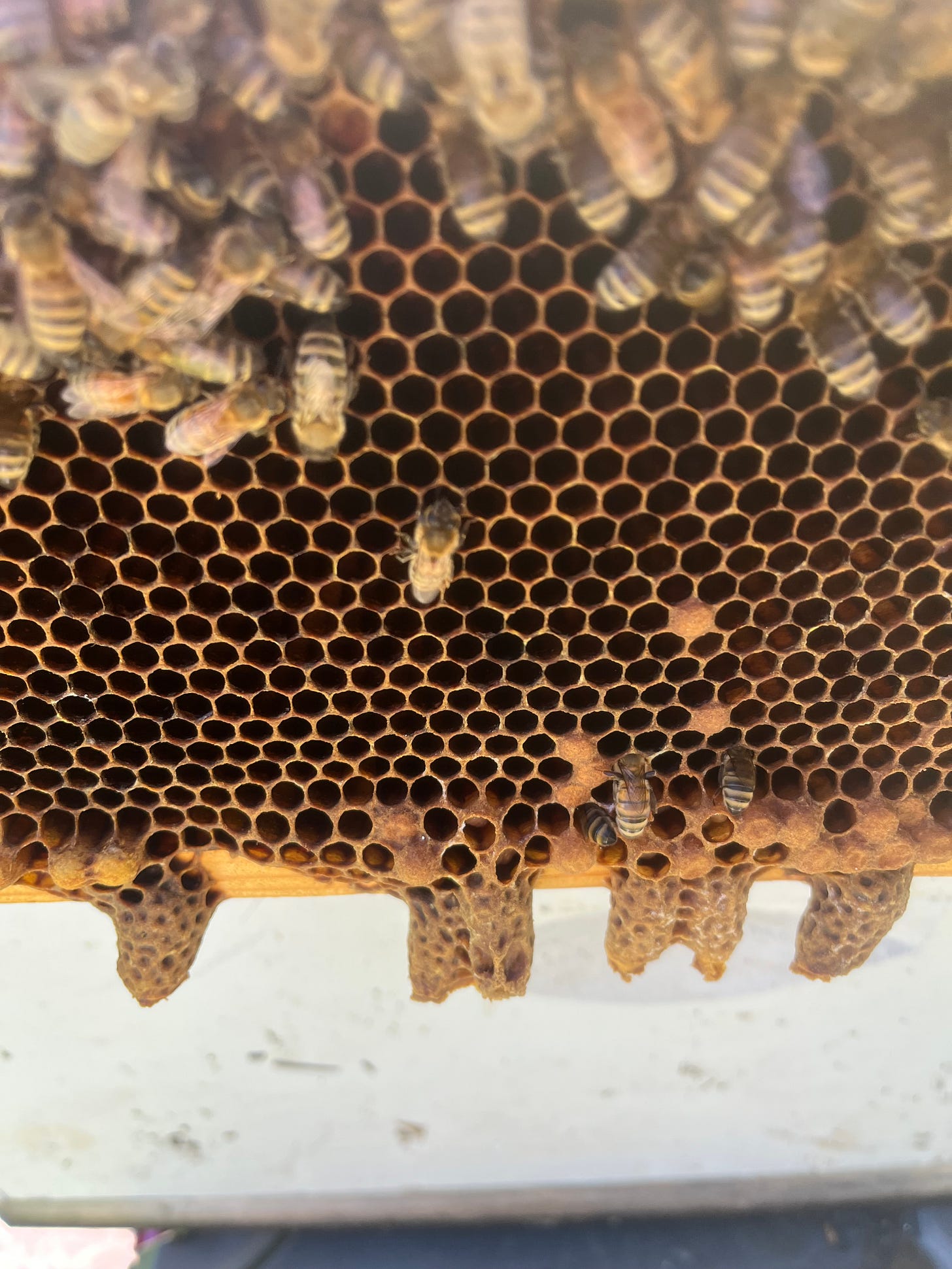In late February, we installed two colonies of bees at Homestead. The equipment we had was new, and I thought it would take the bees several months to create honeycomb on the plastic frames and start filling the box with bees and honey. I was wrong—very, very wrong, it turns out.
Northern California experienced an intense burst of heat in early March, and then we returned to a cool, wet spring. These wild swings in weather confused the bees into thinking we were in true spring. As a result, the bees put on the gas and built out the comb in record time, even starting to fill the frames with honey!
While all this is happy news, the bees were growing too fast and too quickly for their home. When this exponential growth happens too quickly in spring, we get swarming. There are varied opinions on bees and swarming. Some feel that it is natural for them to do and that it is “the cycle of life” in the bee world.
I feel that swarming can cause problems with neighbors and cause you to lose your hive. I had a hive that swarmed, and they left behind six or seven queen cells. In theory, the first queen is supposed to hatch and then kill all the remaining queens that have not hatched. She will be the new queen and will continue the colony with the bees that were left behind.
In my case, the new queen emerged and then swarmed with the rest of the bees and didn’t kill the other queens. Then, the next queen hatched and swarmed again until there was a small trickle of bees remaining, and my hive didn’t make it through the summer. Apparently, these bees didn’t read the book on what they were “supposed to do.”
This spring, my hive at my home swarmed, and this is what it looked and sounded like:
The hive swarmed to our tree and clustered.
The hive then decided to return to the original hive! This is so unusual and extremely lucky, as it allowed me to do a walk-away split (more on that later.)
Here they are, going back into the hive! You can hear I am astounded by this behavior. It is very unusual in the bee world. The general rule of bees is that if the hive has swarmed, it is not going back to the original hive.
I then split this hive. That means you take some frames that are full of bees, resources (honey and pollen), brood (babies) and the queen to create two hives from the original. Splitting the hive take pressure off the original hive and hopefully will relieve the need to swarm.
When I opened the original hive after it swarmed back, it was filled to the brim with queen cells. You do not want queen cells in your hive as this signifies the hive is going to swarm and take half of your population with the old queen. Your honey production will dramatically slow without those workers and nurse bees to take care of the babies in the hive. The new queen takes a while to hatch, mature, and mate, so you are looking at a three-week delay in moving forward with your hive. Meanwhile, your population of workers has been halved, and then it will take another few weeks for new bees to metamorphize from egg to bee and for workers to emerge.
While inspecting our hives at Homestead, I found one box filled with queen cells. We decided to split the hive, and we harvested several frames with queen cells and placed them into a travel NUC (nucleus) transport box.

We swapped these blank frames in the travel NUC for frames full of bees, queen cells, and broods. Hopefully, a new queen will hatch, and a new hive will be born. We found a local beekeeper who was looking for bees, and he came and installed the NUC at his empty hive at home. It's a honey-sweet ending, we hope!
What should you do if you encounter a swarm at your home? This is an actual situation you might run into this spring. If you find some bees clustering in a tree outside your home, do not panic. Google to see if you have a local bee club in your area. At my local club, we have a swarm hotline you can call, and someone will come collect the bees and request a modest donation for the service. We have a very active NextDoor site and Facebook site in our community, and I often see posts about swarms and people who want them to respond. The swarms are not aggressive and are seeking a new home. Your tree might be a resting place until the bees move on to their final location.
Here is what a swarm might look like at your home. Please don’t panic, someone will want them!
Bees are in trouble and not thriving. Some beekeepers have lost over 50% of their colonies this past winter. These ladies pollinate your food, flowers, citrus, and fruit trees. They create delicious sweet honey to sweeten our tea and cakes. They are part of our circle of life. Please take care of them if you cross paths during swarm season.
-Rosalind
(Below is my pear tree being pollinated by the bees.)
Classes and Events
We are super excited to share the first of our 2025 Design Intensives with you all, in addition to our Homegrown Harvest & Herbal Magic series, there are so many ways to come out and join us for some great events!
2025 Design Intensives with Homestead Design Collective, Morningsun Herb Farm & Soul Food Farm
April 16, 2025 The Cut Flower Garden: Design, Plants & Arrangement at Soul Food Farms in Vacaville, Ca 10am -12:30pm
Whether you’re looking to add a cutting garden to your existing landscape or start from scratch, this class will give you the tools to grow your own fresh flowers and create beautiful arrangements to enjoy in your home. Join us for a fun, informative, and creative gardening experience!
What you’ll learn:
Designing a Cut Flower Garden: Learn how to design a garden that prioritizes beauty, practicality, and a continuous supply of blooms. We’ll guide you through the best layouts for easy harvesting and maximizing visual impact.
Choosing Plants for Palette & Fragrance: Explore a variety of flowers and plants to create a harmonious color palette that suits your style. We’ll discuss how to select flowers for both visual appeal and fragrance, ensuring your garden is a sensory delight.
Arranging & Caring for Cut Flowers: Learn the art of flower arrangement, from simple bouquets to more elaborate designs. We’ll also cover essential care tips for extending the life of your cut flowers and keeping your garden thriving all season long.
May 21, 2025 Tea Garden: Design, Plants & Arrangement at a private garden in Lafayette, Ca 10am - 12:30pm
Step into the soothing world of tea with our Tea Garden Design class! This hands-on workshop will guide you through the process of creating your own tranquil tea garden, perfect for both cultivation and relaxation. We’ll explore everything from the art of garden design to selecting the best tea plants, and even enjoy a delightful tea tasting to complement the experience.
What you’ll learn:
Garden Design: Learn how to design a serene tea garden that invites relaxation and enhances the tea-drinking experience. We’ll cover layout, pathways, and creating a peaceful ambiance.
Tea Plants & Selection: Discover the variety of tea plants, such as Camellia sinensis and herbal varieties, and understand how to select the right ones for your climate and garden.
Arranging for Beauty & Function: Learn how to arrange plants to create an aesthetically pleasing and functional garden. We’ll discuss companion planting, layering, and integrating seating areas for enjoying your tea.
Tea Tasting: Experience the flavors of freshly brewed tea made from your very own garden plants. We’ll guide you through a tasting session, so you can savor the full potential of your garden’s harvest.
Homegrown Harvest: A Guide to Growing Your Own Food
April 17 Tomatoes, Tomatoes, Tomatoes —Lafayette, CA Whether you're a seasoned gardener or just starting out, this course offers invaluable insights into selecting the perfect tomato varieties, preparing your soil, and implementing effective planting techniques.
August 7: The Fall/Winter Garden — Lafayette, CA Learn how to plant garlic, cover crops, and cool-season vegetables for your fall and spring edible garden.
Herbal Magic: Cannabis & Herbal Gardening
April 10, Herbal Magic: Cultivating Culinary & Medicinal Plants — Lafayette, CA. Join Stefani Bittner and fellow Ten Speed Press author Penny Barthel for a four-class series on growing culinary and medicinal herbs, including cannabis, in the garden. These two master plantswomen and expert gardeners will guide you through every season of the herb garden, from seed planting to salve making and every step in between.
May 22 Summer Herbs & Cannabis: Companion Planting and Care — Lafayette, CA Dive into the world of synergistic gardening with our specialized class, "Summer Herbs & Cannabis: Companion Planting and Care." This class is designed for gardeners looking to optimize their green spaces through the art of companion planting, focusing on the harmonious cultivation of annual and perennial herbs, including cannabis. You’ll be equipped with the skills to create a thriving garden that leverages the natural benefits of plant relationships.
September 18 Harvesting Excellence: Final Care for Herbs and Cannabis — Lafayette, CA This hands-on course is designed for gardeners who want to master the final stages of the growing cycle and ensure that their herbs and cannabis are harvested and processed with precision and care.
November 13 Kitchen Alchemy with Herbs and Cannabis — Lafayette, CA. Join Penny and Stefani in the kitchen as we use the garden's bounty in bespoke creations in the kitchen. This is what the summer herb garden was heading for all season! We become kitchen alchemists as we transform our harvested herbs into tisane, tincture, infused oil, salve, and delicious beverages and edibles. Penny will offer instruction on the unique properties of cannabis for health and wellness as we include it in the herbal ingredients in our creations. Come prepared to learn by doing as we make several favorite herbal recipes for mind, body and soul.








It is really important that bee keepers pay attention to their hives to prevent swarming. You can think of honey bees like chickens. They are great if you want eggs and enjoy the husbandry but the wild areas do not benefit from them. We don't want them to be wild in the environment because they compete with our native bees and can transfer disease.
Great article and reels, Rosalind! So interesting to learn about bees and these unusual queen bee patterns. Best of luck going forward!🦋🌼🌸